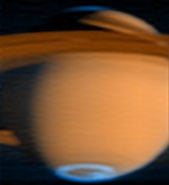Saturn’s gorgeous rings. Geysers on Enceladus. Methane lakes on Titan. These are just a few of the images that stand out from the Cassini mission’s four year survey of Saturn and its remarkable system of rings and moons. On June 30 the Cassini spacecraft completes its primary mission at the ringed planet, and now will embark on an extended two year mission, with hopes of studying more closely the most intriguing targets, Titan and Enceladus and the interaction between Saturn’s icy moons and rings.
"We've had a wonderful mission and a very eventful one in terms of the scientific discoveries we've made, and yet an uneventful one when it comes to the spacecraft behaving so well," said Bob Mitchell, Cassini program manager at NASA's Jet Propulsion Laboratory, Pasadena, Calif. "We are incredibly proud to have completed all of the objectives we set out to accomplish when we launched. We answered old questions and raised quite a few new ones and so our journey continues." Mitchell said while its clear Cassini isn’t just driving off the showroom floor, considering how complex the nature of the mission has been and how long it’s been going, the spacecraft is doing remarkably well.
Cassini launched Oct. 15, 1997, taking seven years to traverse 3.5 billion kilometers (2.2 billion miles) to Saturn. The mission entered Saturn's orbit on June 30, 2004, and began returning stunning data of Saturn's rings almost immediately.
Mitchell said the spacecraft has made major discoveries about the dynamics of the rings, and how the moons gravity shapes the rings into the different gaps. “The geysers of Enceladus rank near the top of the excitement of the discoveries that we’ve made,†he said. “ Titan is very different than we expected it to be. It’s a lot like Earth, if you just replace water with methane there a lot of processes on Titan that look like Earth.â€
The extended mission will allow for monitoring seasonal effects on Titan and Saturn, exploring new places within Saturn's magnetosphere, and observing the unique ring geometry of the Saturn equinox in August of 2009 when sunlight will pass directly through the plane of the rings.
The next two years, Cassini will have 26 more encounters with Titan, seven close encounters with Enceladus, and one each with the icy moons Dione, Rhea and Helene.
And there’s sure to be other discoveries at Saturn as well. “There are a number of surprises yet waiting for us, as the seasons change, we’re bound to find exciting things we haven’t even thought of yet,†said Mitchell.
Original News Source:
JPL
 Universe Today
Universe Today
